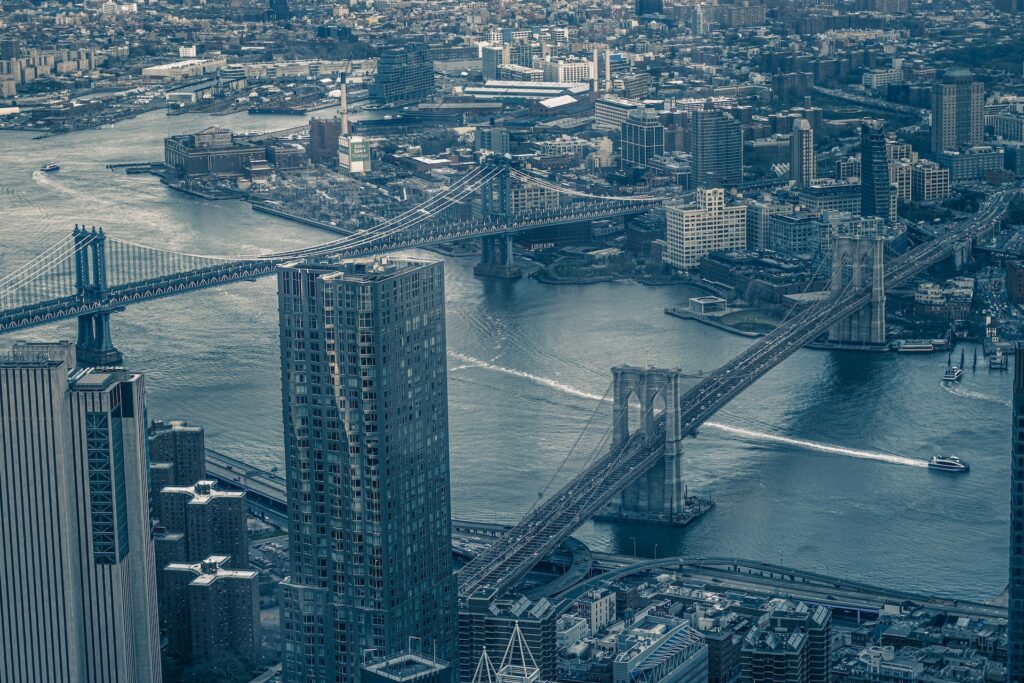Brooklyn Bridge – The Story of an NYC Landmark
Brooklyn Bridge – The Story of an NYC Landmark
The Brooklyn Bridge is an historical symbol of New York and a fundamental part of the city. Considered a world reference, it was cataloged as one of the wonders of 19th century engineering, a must-see postcard for all visitors who set foot on New York soil and of course the setting for numerous films such as Godzilla, Cloverfield or The Amazing Spiderman 2,
It was inaugurated 140 years ago, more precisely on May 24, 1883, thus establishing the union between the county of Brooklyn and the island of Manhattan, which until then had only been connected by ferry. The bridge came to bring a great benefit to the population because when there were strong storms, or during winter, passenger transport had to face numerous difficulties and even the service was suspended because weather conditions prevented the movement of passengers. boats.
The story goes that it was in 1852, when on one occasion the German John Augustus Roebling, who was a civil engineer and pioneer in the design and construction of suspension bridges, could not reach Brooklyn with the Atlantic Avenue – Fulton Street Ferry due to the license plates. ice, and decided to propose the construction of this bridge. Three years later the project was approved, with the backing of the engineer, businessman and politician William C. Kingsley, who obtained the financial support of private investors.
It was so that on the day of its inauguration, around 150,000 people crossed the bridge, after paying the fee of one cent. The first person to do so was Emily, Roebling’s daughter-in-law, who after an accident died without seeing her finished masterpiece. It was Emily herself who, without being an engineer, finally supervised the project until the end.
At first, the bridge was called the New York and Brooklyn Bridge, and later became the East River Bridge, until it was officially called the Brooklyn Bridge in 1915.
Its truly impressive dimensions, 1,833 meters long, were not enough to generate confidence about its resistance. It was so that many doubted if it could support so much weight and it was perhaps this fear that gave rise to a stampede, a few days after its opening, which caused twelve deaths and seven serious injuries, according to the New York Historical Society.
In order to convince people that the bridge was safe, and that it was not going to collapse, on May 17, 1884, at the hands of the Barnum circus, a curious parade was organized with 21 elephants led by the iconic Jumbo, an elephant seven tons, which walked across the bridge accompanied by 17 camels weighing between 600 and 1,000 kilos. who together created a captivating spectacle for the inhabitants of the city.
After this curious event, the structure, built with limestone, granite, cement and steel, proved to be completely reliable and safe, leaving as a result absolute confidence about its solidity.
Today, the Brooklyn Bridge remains a landmark of New York and a vital crossroads for the city. Every day around 116,000 cars cross its six lanes, while 3,000 cyclists use the two dedicated lanes for them. Also, more than 30,000 people walk on the upper platform every day.
Some curiosities of the bridge:
In 2006, in one of its basements, a kind of bunker or anti-war shelter was discovered, from the Cold War era, where packages with medicines, food and blankets were kept.
Currently crossing the bridge is free, but until 1911 there was a toll, and the rates were 1 cent to cross on foot, 5 on horseback and 10 for those traveling by carriage.
For two decades it was the longest suspension bridge in the world and the first suspended with steel cables, quite a technological innovation at the time. 20 years later the place of honor was taken away by the neighboring Williamsburg Bridge, in 1903, with only 1.37 meters more.
Those passing over the bridge may see peregrine falcons, who routinely use the two towers as their nesting grounds. Peregrine falcons are the fastest animals ever, capable of reaching speeds of over 200 miles per hour. They disappeared from the eastern United States due to pesticide poisoning, but reappeared after the pesticide was banned in 1792.
The four main cables that support it are still the original ones of the structure
On March 1, 1994, there was a terrorist attack: Lebanese Rashid Baz shot a van occupied by members of the Chabad-Lubavitch Jewish Orthodox group while they were driving over the Brooklyn Bridge.
We have the unbeatable price of $500 per day for your Billboard:
Option 1: Your 60 second video/photo will be shown, 60 seconds per hour 22 times a day.
Option 2: Your 30 second video/photo will be shown, twice an hour, 44 times a day.
Option 3: Your 15 second video/photo will be shown 4 times per hour 88 times per day.
Please let us know which option you would like to choose. Remember that we have a response time of 72 hours.
Puente de Brooklyn y su interesante historia
Tenemos el precio imbatible de $500 por día para tu Billboard:
Opción 1: Se mostrará su video/foto de 60 segundos, 60 segundos por hora 22 veces al día.
Opción 2: se mostrará su video/foto de 30 segundos, dos veces por hora, 44 veces por día.
Opción 3: Se mostrará su video/foto de 15 segundos, 4 veces por hora 88 veces por día.
Por favor, háganos saber qué opción le gustaría elegir. Recuerde que tenemos un tiempo de respuesta de 72 horas.

